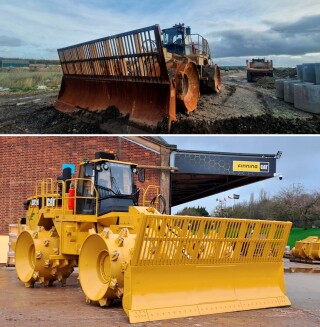It took just 12 weeks to transform this 15-year-old machine for FCC Environment, shown here before and after, rebuilt with a mix of reconditioned and remanufactured parts.
FCC Environment owns and operates more than 200 waste management facilities across the UK, managing more than 8.5 million tonnes of trash for 72 local authorities.
Machines operating in landfill sites need to be hardy and robust. Fifteen years of service can deliver quite some punishment.
FCC’s waste processing fleet comprises 500 machines including landfill compactors, wheeled excavators, tracked loaders and articulated dump trucks. It purchased the Cat 836 landfill compactor from Finning back in 2007.
When the transmission on the machine failed at the end of 2022, FCC plant manager Bill Stone was faced with the traditional repair or replace dilemma.
and recently brought it back for more than your usual kind of service.
“As a company operating in the waste and recycling sector, we understand how important it is to embrace sustainable approaches across all aspects of our business and have transformed our operations accordingly to limit our company-wide environmental impact,” he says.
“While sustainability played a big role in our decision, we also needed to weigh up the time it would take and how much it would cost. The lead time for a replacement machine, for example, was longer than the estimated three month rebuild turnaround. Crucially it was Finning providing reassurance on the quality and performance of the machine that was the tipping point, so we commissioned them to carry out the rebuild.”
This rebuild project was led by Finning’s Ben Marston and Thomas Raybould. The first task was to disassemble the machine piece by piece – draining off the oils and fluids from all major components, disconnecting them and removing the axles so the engine, torque convertor and pumps could be taken out in one go. Then the transmission, fuel tank and steering cylinders were removed ready for the engineers to wash down and carry out a detailed inspection of the machine and cab to identify the full scope of work required to get the machine back to as new condition.
“This was easily one of the most challenging rebuilds I’ve been involved in,” Ben Marston says. “The harsh environment that the machine has been operating in has taken its toll on every part of the machine. The transmission was the worst I’ve ever come across, and the cab was falling to pieces when it came in.

“A key part of the inspection process involves identifying which parts can be reconditioned and reused. In this case we were able to restore and reuse seven of the 10 radiator cores.”
The reassembly phase can take up to nine weeks, depending on the size and complexity of the machine and reconditioning required.
A key part of the rebuild process involves upgrading components or systems within the machine to the latest technical update that would have been introduced during the machine’s production life. This machine had a mix of remanufactured and reconditioned components. Once the major elements were refitted and the cab reinstalled, all the electrical elements were reconnected, and the oil and coolant topped up, so the machine was ready to be restarted.
Performance testing is a critical phase of a rebuild, where all components are assessed to ensure they are within Caterpillar’s approved specifications. This includes the first full run of the machine, which includes bleeding all the systems and testing the electrics. Then the engine, transmission and hydraulic systems are given a thorough work out by performing pressure checks and critical electronic calibrations.
Once the panel work is reinstalled, the fire suppression and reverse camera systems are fitted – a mandatory safety requirement for machines working in landfill environments.
The rebuilt machine has now been back and operational on site for around three months.
Bill Stone says: “Our mobile plant fleet is key to our operation, so it is essential these assets are managed effectively, and Finning plays a vital part in that. The strong aftermarket support we’ve received over the years provided reassurance and confidence in deciding to have this machine rebuilt.
“The process did evolve from the original scope. This was due to many of the components of the machine only being exposed and their true condition seen once the machine was taken apart in the workshop. The finished machine sounds and looks fantastic and is a testament to the skills but also the pride of all those involved.
“Doing the right thing is vital, and choosing the sustainable option makes good business sense, and a route we will continue with as part of our fleet succession plan.
“We’ve been impressed with all aspects of this machine rebuild both in terms of the skill of the engineers, the level of communication throughout the process and in the quality and performance of the machine. We’re already in discussions with the team at Finning about commissioning another rebuild in the next few months.”


